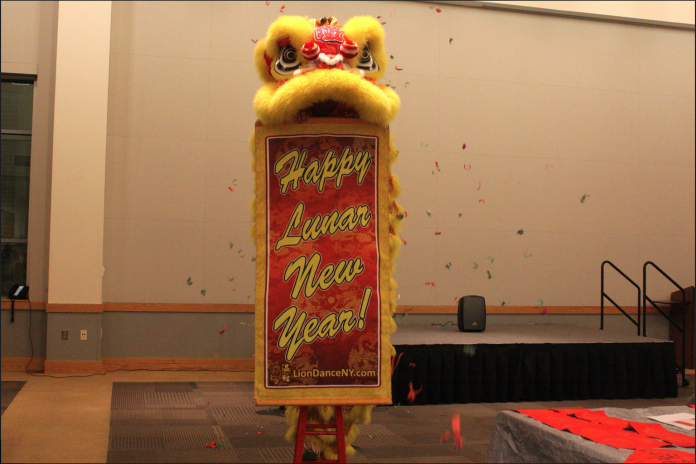During the last week of January, the Asian Student Association hosted their annual campus-wide celebration of the Lunar New Year. From Monday, Jan. 27 until Thursday, Jan. 30, the entire campus was aglow with a plethora of fascinating cultural activities, and Muhlenberg students had a taste of all that the Year of the Rat would bring.
‘Berg community members enjoyed the kickoff of the Lunar New Year celebration by relishing in some delectable dumplings in the lower level kitchen, and the halls of Seegers quickly transformed before everyone’s eyes into a breathtaking Chinese cultural hub. Lanterns were hung all over the ceiling of the Fireside Lounge, massive red-and-gold balloons gracefully adorned the overhang beside the entrance to the Wood Dining Commons and streamers of various colors could be found throughout the building as the week progressed.
On Tuesday, Jan. 28, the ASA hosted a cultural panel in the Great Room, which was followed by Wednesday’s Tea Around the Globe event in the Event Space, both of which saw considerable turnouts and further informed the student body about the various different components that comprise the Lunar New Year Festival in Asia, as opposed to the New Year’s Eve traditions in America.
Lily Arovas ’23, an attendee of the cultural panel, said, “Well, there is definitely a good amount of information I didn’t know about Chinese culture, and I guess the biggest shock was how much ancestry works its way into their society. If we had that here, it’s crazy to think how much more respectful we would be of our elders.”
On Thursday, the ASA brought in a surprise: a huge Chinese lion, piloted by two brave volunteer members. The moment the gargantuan creature stormed through the doors of the dining hall, the attention of hundreds of students was directed towards it. Dozens of students on the second floors crowded around the railing to get a good look at the unexpected visitor, and awestruck gasps filled the vast corners of the tall-ceilinged room. While the lion stole the show, members of the ASA took the opportunity to present onlookers with traditional red envelopes, a crucial and intriguing facet of the celebration, profoundly different than American gift exchanges on the Gregorian New Year.
To learn more about the red envelopes and a variety of other Lunar New Year cultural symbols, The Weekly reached out to Robin Chodak ’22, an ASA member and major contributor to the setup of the week’s festivities. Chodak explained that the exchanging of these red envelopes is a popular tradition in Tibet, and it is customary to present one using both hands out of respect for the recipient.
“It’s customary to give lots of gifts,” Chodak explained. “It’s about celebrating the future, sure, but the main purpose is definitely about sharing and showing appreciation for the people in your life.”
As for the lion, Chodak explained that in China, a similarly human-piloted lion is commonly seen parading through the streets of cities and towns, known for chewing up cabbage in order to usher in the coming year. After the lion’s festivities were finished, participants could exit the front entrance of Seegers and find a plethora of sparklers, symbolically traditional to the celebration.
“Sparklers are huge at night,” continued Chodak. “They’re used to scare off evil spirits, but they’re also just festive.”
When the conversation turned toward the final event of the evening, the widely popular “Rat Stuff-a-Plush,” Chodak chuckled, describing how the practice isn’t one that’s native to Chinese culture in any way, but is rather a fun, adorable way to get even more people interested in the activities. He followed that by pointing out that the lunar calendar names every lunar year as an animal within a cycle that has been long passed down through Chinese history. As can be inferred, the stuff-a-plush event is inspired by the fact that the coming year is the “Year of the Rat.”
When asked what the importance of the popularity of the Lunar New Year celebration truly was to the ASA, Chodak responded, “I guess there are two main things: it’s an opportunity to make students of Asian origin feel like they’re welcome on campus, and it’s a fantastic opportunity for these students to share their culture with their community.”
He then explained that the main theme of the holiday was to wish peace and prosperity to family, neighbors and people who have made an impact on one’s life, and at Muhlenberg, it is an outlet to share a tradition that many people are likely not totally aware of.
“In the future,” Chodak concluded, “we know that people here love our dining hall’s food, and we’re looking to expand the horizons of these celebrations to cover food from even more Asian countries than just China. This year we mainly focused on China in general, but we hope to use the popularity we got to get even more diversity recognized on campus.”






















